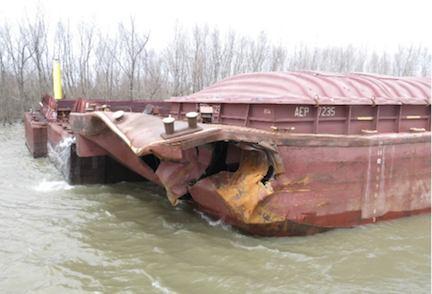The following is a marine accident brief from the National Transportation Safety Board (NTSB):
(WASHINGTON) — At 1917 local time on Feb. 13, 2019, the towing vessel Miss Dixie was transiting downbound with a crew of four and pushing five barges on the Lower Mississippi River near New Orleans, La., when it collided with the upbound towing vessel D.& R. Boney, which was pushing nine barges. Several barges broke loose from their tows and were subsequently gathered up by the crews of the towing vessels. No injuries or pollution were reported. The cost of damage to four barges was $294,530.
Probable cause
The National Transportation Safety Board determines that the probable cause of the collision between the tows of the towing vessels Miss Dixie and D.&R. Boney was the lack of an effective maintenance program aboard Miss Dixie, resulting in excessive and undetected wear of the port clutch, which compromised the vessel’s maneuverability.
Click here to read the complete report.
Analysis excerpt
As the captain of Miss Dixie was maneuvering around the bend at Nine Mile Point, he experienced a reduction in thrust from the port propeller, which reduced his ability to steer around the sharp turn. About the same time, a deck hand in the engine room observed smoke in the area of the port clutch and smelled rubber burning. In a hairpin turn, with an eddy from the current and several other vessels transiting the area, the captain needed thrust from both propellers to successfully maneuver the 700-foot tow; without sufficient thrust from the port propeller, the captain was unable to effectively control the tow. After the accident, based on the location of the smoke and the reduction of power from the port propeller, the crew believed that the clutch had been slipping and overheating, which reduced thrust to the port propeller. The crew determined that there had been an issue with the port clutch.
Further, a post-accident inspection by a service representative found that the port clutch had excessive wear, would slip, and was only 40 percent operational. The air-actuated clutch was designed to transfer torque from the engine to the propeller by inflating a rubber air tube within a steel ring, forcing friction shoes onto the rotating assemblies, which would rotate the propeller at a proportional speed to the engine. Heat is generated by a slipping clutch, producing smoke from the overheating of components in the clutch system, such as the rubber tube, and results in a reduction of power being transferred to the propeller. Without records to show any previous maintenance or inspections of the clutches aboard Miss Dixie, the condition of the units before, or at the time of, the accident is unknown.
The owner indicated that the engines had been overhauled prior to the acquisition of Miss Dixie but was not sure if the overhaul included the clutches. The clutches were not inspected over the six months of ownership, and the owner had not developed periodic inspection or maintenance procedures per manufacturer’s guidance associated with the clutches, which are critical components of the propulsion system.

